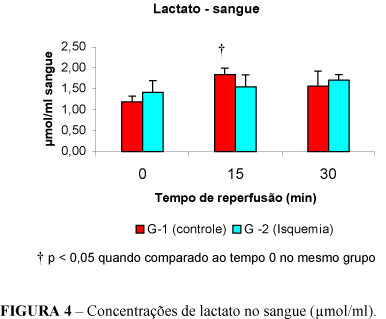PURPOSE: To investigate the metabolic alterations in the eye and arterial blood of Wistar rats submitted to bilateral common carotid artery clamping. METHODS: thirty-six males adult rats were submitted the dissection (group-1, sham, n=18) or dissection+clamping (group-2, experimental, n=18) of common carotid arteries, under general anesthesia. After 30 minutes of ischemia (time 0) and during reperfusion (15-30 minutes) arterial blood samples were collected. Simultaneously right eye enucleation was carried out. RESULTS: The significant decrease of tissue piruvate concentrations 15 min (0,693±0,132 versus 1,195±0,118 µmol/g, p<0,01) and 30 min (0,764±0,182 versus 1,195±0,118 µmol/g, p<0,05) of onset of reperfusion (time 0) in group-2 rats suggests increased use of piruvate for energy production in Krebs cycle. The significant increase of tissue lactate (group-2 versus group-1), in time 0 (8,843±0,902 versus 3,134±1,182 µmol/g, p<0,01) remaining elevated during the whole reperfusion phase, suggests continuous use of the anaerobic glicolytical pathway, in spite of the offer of O2, in ischemia-reperfusion injured tissues. Increased uptake (group-1) might have been the cause for the significant increase of ketone bodies concentrations in the eye, during reperfusion (15-30 minutes). CONCLUSION: Bilateral carotid artery occlusion, for 30 minutes, induces significant alterations in the energetic metabolism of eye tissue, with maintenance of the anaerobic glicolytical pathway after re-establishment of the arterial flow.
Eye [metabolism]; Ischemia; Reperfusion lesion; Rats







